Summary of climate disasters on the planet from June 18 to 24, 2025
Here’s the situation, friends:
even those who have already faced severe weather events want to forget what happened — to simply return to their habitual lives as if nothing ever occurred. Many aren’t ready to admit that this is not a coincidence, but part of a growing climate crisis that will only intensify. And those who have been spared so far try not to think about it at all.
But the reality is that the most serious threat facing all of humanity today is the rapid escalation of natural disasters. And you will find confirmation of these words in the summary of events from the past week, June 18 to 24, 2025.
And you will also learn how to protect yourself and your loved ones amid climate chaos.
China
On June 24, in Sandu County, Guizhou Province, a powerful landslide, triggered by several days of heavy rain, destroyed part of a bridge over the Houzi River on the G76 Xiamen–Chengdu Expressway, which connects the provinces of Guangxi and Guizhou.
The incident occurred early in the morning when a truck was driving over the bridge. The driver managed to react and brake in time, but the truck cab was literally left hanging over the abyss. He could not get out on his own. There were eyewitnesses at the scene, but there was no way to call rescuers because there was no cell signal in the collapse area. Moreover, the road surface began to crack, and approaching the truck was extremely dangerous.
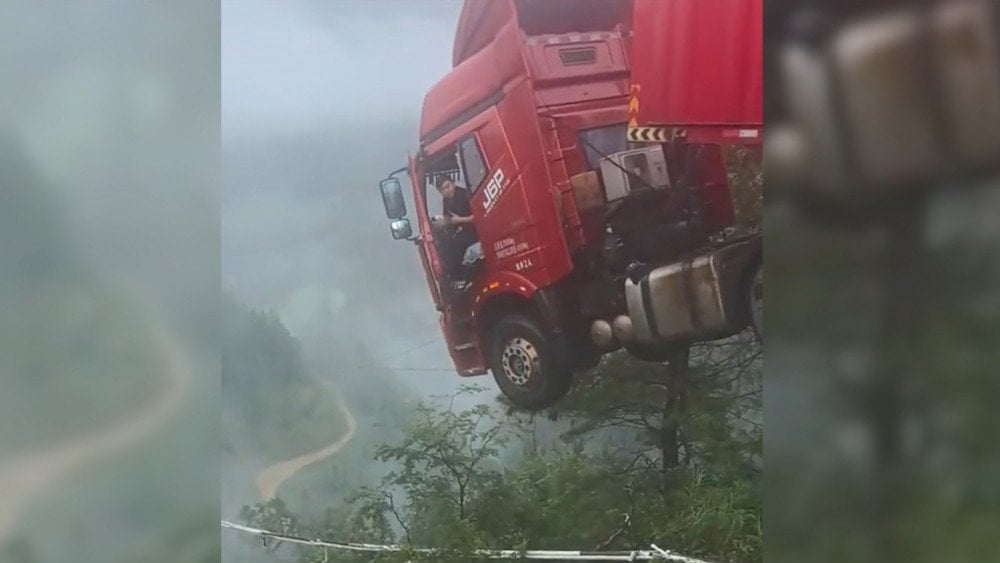
Because of a landslide in China, the bridge collapsed—the truck miraculously held on and was left hanging over the abyss
Local residents called rescuers, who after just over an hour, using ropes and ladders, were able to get the driver out of the cab.
During further inspection of the area, the rescue team discovered that the landslide had swept away four residential houses and several cars. Within three hours, 16 (sixteen) people were found and evacuated. Fortunately, there were no casualties.
Kazakhstan
On June 19, a powerful storm hit the Pavlodar Region of Kazakhstan. Hurricane-force wind gusts reached 43 m/s (154 km/h or 95 mph). Dozens of buildings were damaged, including hospitals, kindergartens, and administrative facilities.
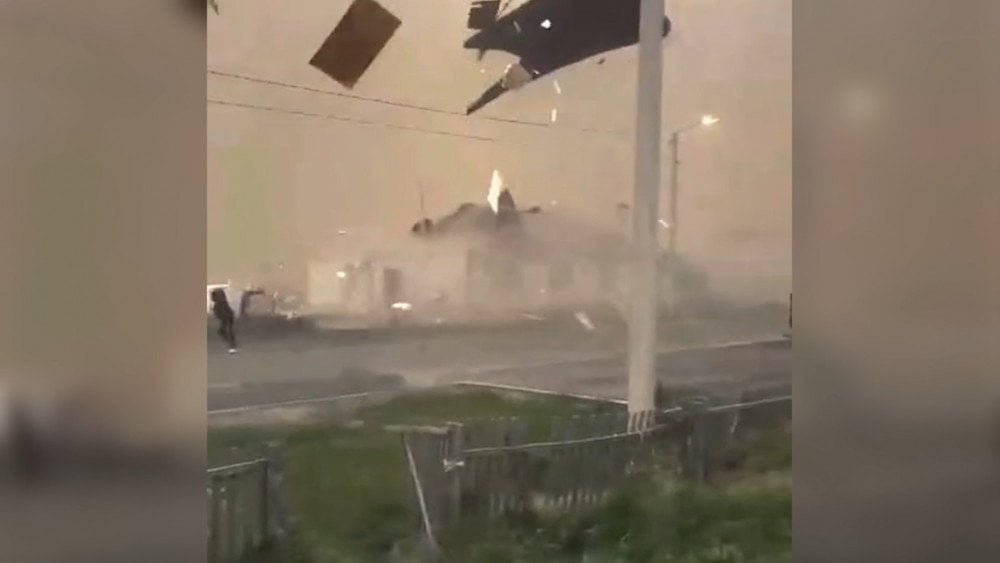
Hurricane-force wind tore the roof off a building, Pavlodar Region, Kazakhstan
In the city of Aksu, a tower crane collapsed onto the roof of a 9-story residential building, and cladding fell off the walls of two newly constructed buildings. Fallen trees crushed cars, and a GAZelle van flipped over on the roadway.
In Pavlodar, part of the white arches along the embankment collapsed, and the wind tore away sunshades on the beach. Courtyards all over the city were littered with broken branches. The wind overturned bus stops, and the roof of the akimat (local administration building) was damaged.
Unfortunately, in the city of Aksu in Pavlodar Region, a woman was killed—a tree fell on the taxi she was riding in.
Cities and districts of the region were left without electricity.
Seventeen people, including seven children, suffered bruises, abrasions, lacerations, and in one case—serious fractures.
Mexico
On June 19, tropical hurricane Erick struck Mexico’s Pacific coast. According to data from the U.S. National Hurricane Center (NOAA), it made landfall between the cities of Acapulco and Puerto Escondido.
The day before, Erick had rapidly intensified, turning in just 24 hours from a tropical storm into a devastating Category 4 hurricane. Before making landfall, it weakened to Category 3, which reduced the aftermath. At that moment, the wind speed at the hurricane’s center reached 205 km/h (127 mph).
In the state of Oaxaca, torrential rains and gale-force winds caused flooding, landslides, and infrastructure damage: roads, schools, hospitals, and residential homes were affected.
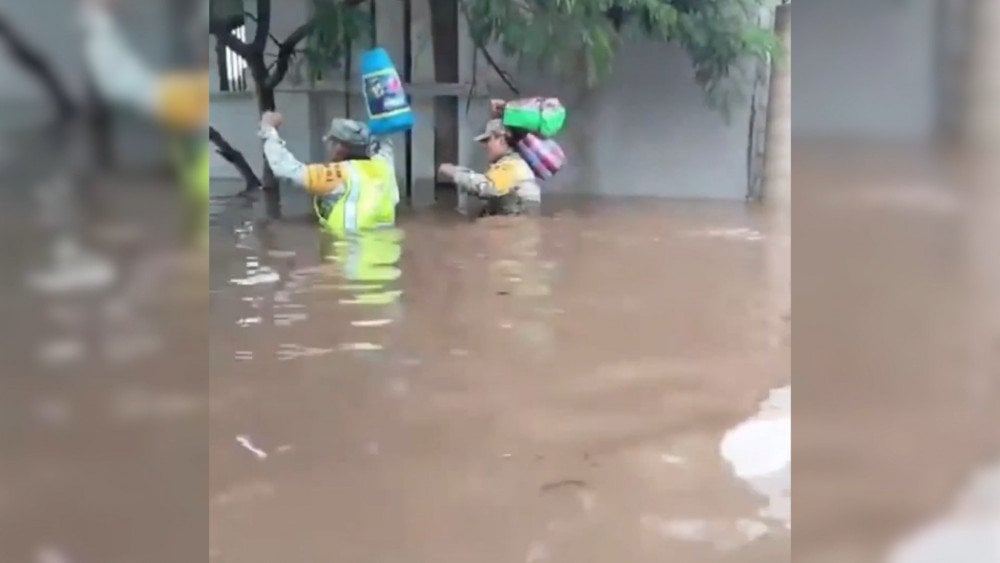
Heavy rains caused by tropical hurricane Erick flooded residential neighborhoods in the state of Oaxaca, Mexico
The cities of Puerto Escondido, Salina Cruz, and Pinotepa Nacional were especially affected.
In the municipality of San Pedro Pochutla, one person died.
Another tragedy occurred in the state of Guerrero, which was also seriously affected by the disaster. Here, a one-year-old child drowned when the mother tried to cross the swollen river carrying the child in her arms.
Despite the fact that due to the country’s mountainous terrain the hurricane began to weaken quickly and had completely dissipated by the evening of June 20, the rains continued, causing prolonged flooding. In the state of Michoacán, where the remnants of the storm arrived during the night of June 20, flooding and transportation disruptions were reported. According to official data, more than 277,000 people were left without power and communication.
Tropical hurricane Erick became the first Category 3 or higher hurricane ever recorded to strike Mexico’s Pacific coast before July.
Nepal
Torrential monsoon rains triggered numerous landslides and floods in Nepal. Throughout the country, transport links were disrupted: key highways were blocked, and local roads were flooded and damaged. Sudden floods put people’s lives at risk. Rescue operations were deployed in the affected areas.
On June 18, in Kailali District, Sudurpaschim Province, a group of Indian tourists was relaxing on the riverbank when the water suddenly rose and completely inundated the surroundings. As a result, they were stranded on a small island cut off from the mainland. Rescuers evacuated all the trapped people using ropes.
And on June 19, in Gandaki Province, a passenger bus traveling the route from Kathmandu to Nepalgunj was crossing a temporary bypass at the shallow section of the Binayi River in Nawalpur District when it was swept away by a sudden strong current.
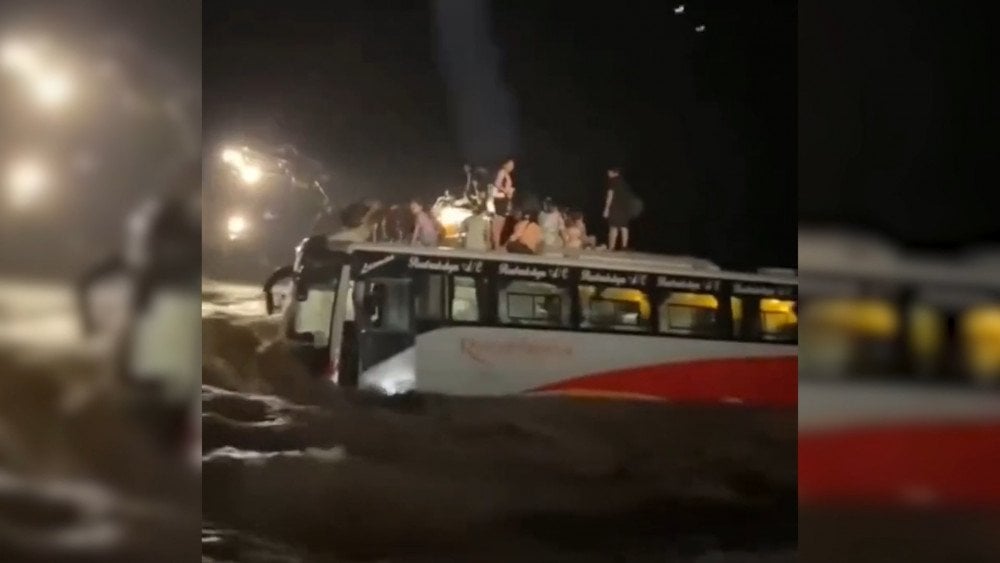
Passengers are waiting for help on the roof of the bus swept away by a sudden strong current in Gandaki Province, Nepal
All 38 passengers, including three infants, survived, but they had to be rescued with the help of an excavator. The bus was carried about one kilometer (0.6 mi) downstream. It could not be pulled out due to the ongoing heavy rains.
India
Due to the influence of the monsoon, torrential rains fell across India, causing large-scale floods and landslides. Rivers overflowed their banks, and powerful currents swept away cars and inundated residential areas. Water entered homes and damaged property. Some buildings were completely destroyed. Many roads, including the Delhi–Gujarat National Highway, were closed due to landslides, flooding, and bridge collapses.
In the state of Gujarat, water flooded villages, destroyed crops, and cut people off from the outside world.
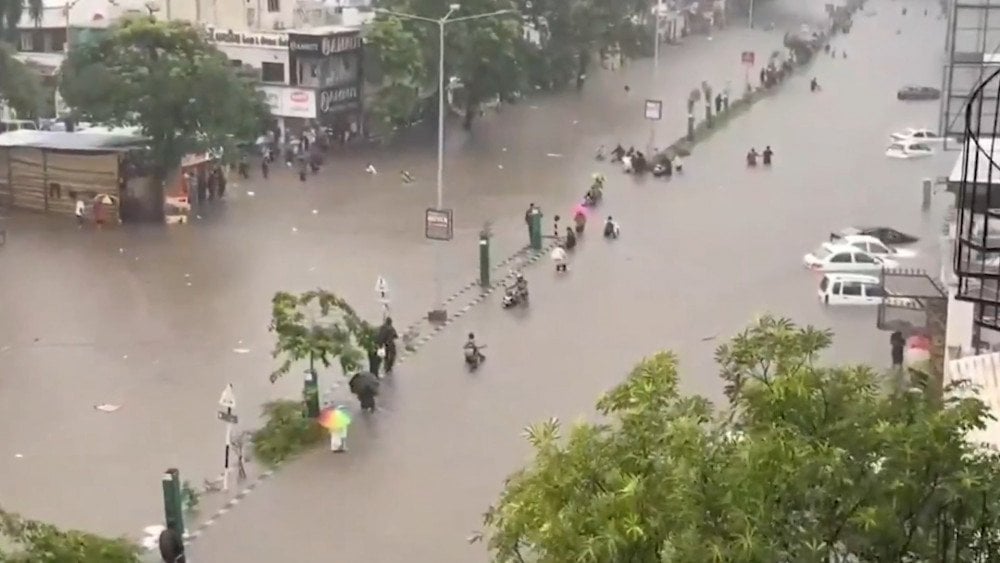
Torrential rains flooded the streets of Surat in Gujarat, India
Rescuers had to evacuate more than 100 people trapped by the floodwaters, and hundreds of farm animals were urgently moved to higher ground.
On June 19, in Botad District, near the village of Latidad, a tragedy occurred: a car attempting to cross a flooded section was swept away by a sudden strong current. There were 9 passengers in the car. Unfortunately, seven of them could not be saved.
On June 23, in the city of Surat in Gujarat, about a month’s worth of rain—177.8 mm (7 inches)—fell in just four hours. Water flooded streets, buildings, and shops, and schools had to be closed.
In Dakshina Kannada District, Karnataka state, a landslide disrupted train traffic on the important Sakleshpur–Subrahmanya railway section.
On June 22, in the city of Ujjain, Madhya Pradesh, prolonged rainfall caused the ceiling of a passageway in a temple complex to collapse. The entrance to the sacred Mount Gupt Godavari was closed to pilgrims due to strong water flow. Several temples along the banks of the Godavari River were also submerged.
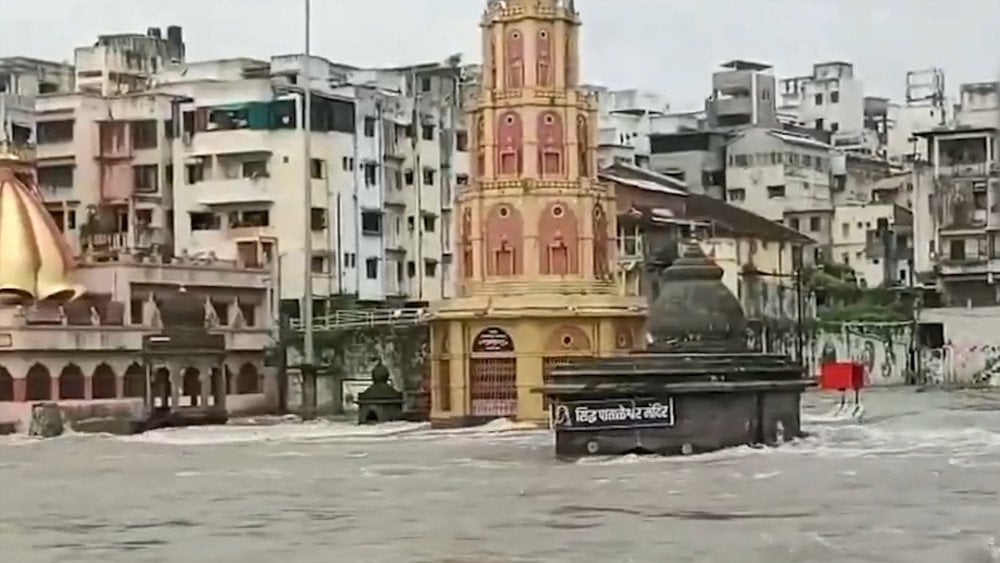
Flooding in India engulfed sacred sites: temples on the banks of the Godavari River were submerged
The disaster claimed the lives of at least 24 people, with five still missing.
Russia
Vast areas of Siberia and Transbaikal were gripped by a heatwave that broke multi-year records and brought scorching heat unusual for these latitudes. The average daily air temperature exceeded the climate norm by 6–9 degrees.
On June 19 in the village of Uglovskoye, Altai Krai, the temperature rose to +38°C (100.4°F).
In Buryatia on June 21, a temperature record was broken — in the village of Barguzin, a temperature of +36.5°C (97.7°F) was recorded. And on June 22 in the settlement of Novoselenginsk, Transbaikal, the temperature reached +38.3°C (100.9°F).
In the city of Chita, Transbaikal Krai, a new daily maximum was set— +37.5°C (99.5°F), exceeding the 1991 record by 3.3°C (5.9°F).
On June 19 in Novosibirsk Region, at the Suzun weather station, a temperature of +35.2°C (95.4°F) was recorded, breaking the 1996 record (+33.6°C / 92.5°F).
On June 20, the village of Sym in Krasnoyarsk Krai, where +39.8°C (103.6°F) was recorded, became the hottest place on the territory of Russia.
And the day before in the regional capital, the city of Krasnoyarsk, the air warmed up to +35.3°C (95.5°F), exceeding a 45-year-old record (1980 Tmax = +33.1°C / 91.6°F).
To prevent deformation of asphalt heated up to 50°C (122°F) and to avoid accidents on the roads, streets in Krasnoyarsk were cooled with watering vehicles.
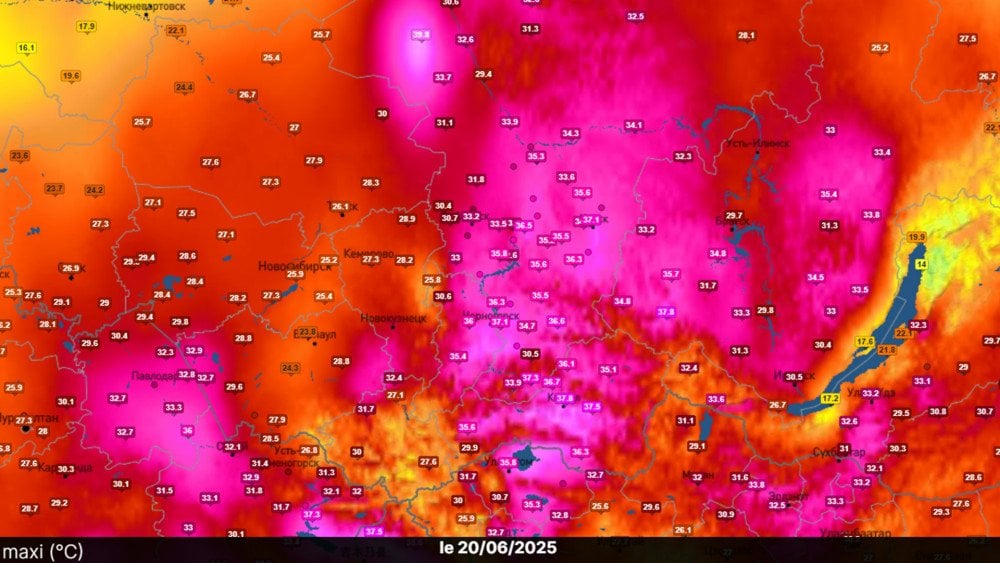
Abnormal heatwave engulfed the territory of Siberia and Transbaikal in Russia
On June 21 in the city of Kyzyl, Tuva Republic, the weather station recorded +38.6°C (101.5°F), which is almost 12 degrees above the average June maximum (+26.9°C / 80.4°F).
And in Irkutsk, a temperature record that had held for 129 years was broken: on June 21 the maximum temperature reached +34.5°C (94.1°F) (the record of 1896 was +33.7°C / 92.7°F). In the city, 11 people sought medical help for heatstroke.
Meanwhile, in Central Russia it was unseasonably cold. On the night of June 22 in Kostroma Region the temperature dropped to 0°C (32°F), in Yaroslavl, Ivanovo, Vladimir, and Ryazan Regions — to +4°C (39°F), and in the Moscow Region it was only +2°C (35.6°F).
In Karelia, Arkhangelsk Region, and the Komi Republic, frosts were recorded. And in Murmansk Region, there was even snowfall.
Brazil
The state of Rio Grande do Sul in southern Brazil was hit by large-scale floods caused by heavy rains that struck the region starting June 17.
A total of 127 municipalities were affected by the disaster. Nearly 8,000 people were left without shelter.
Due to destroyed bridges, debris, and landslides, traffic was blocked on 29 sections of federal and local highways.
The water level in the Jacuí River suddenly rose by 10 meters (33 ft), flooding the famous Fandango Bridge on BR-153—one of Brazil’s key federal highways. This bridge is a historic symbol of the city of Cachoeira do Sul and an important part of the entire state’s transport system.
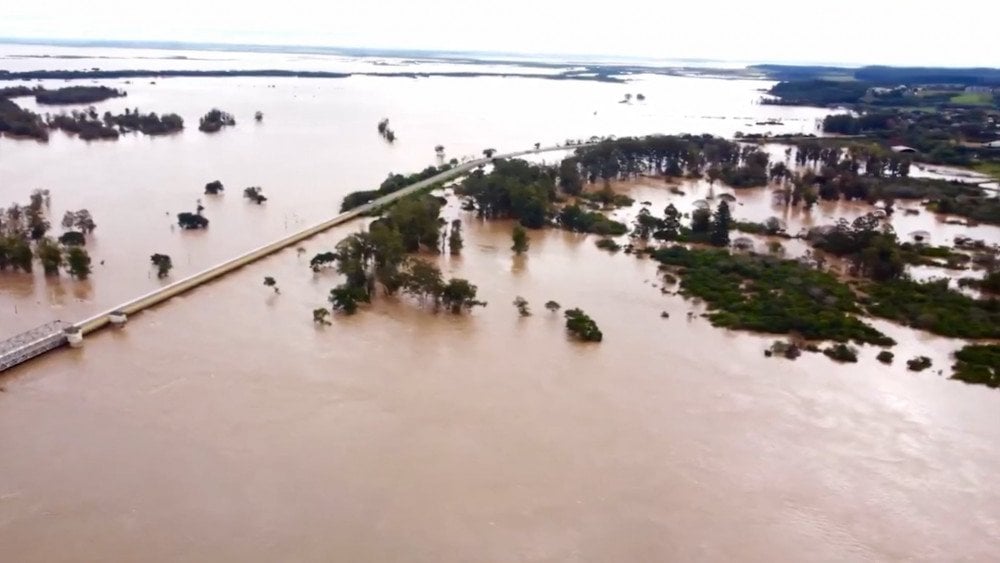
The Jacuí River overflowed and flooded vast areas in Brazil
Water entered residential neighborhoods and forced people to leave their homes. Authorities declared a state of emergency.
A complicated situation developed in the municipality of Canoas, where the Praia de Paquetá neighborhood was completely flooded, and transportation was only possible by ferries and jet skis.
In the municipality of Campo Bom, a teenager spent two hours clinging to a tree in the middle of a raging current after his boat capsized. Rescue teams could not reach him due to the strong flow, but in the end, he was evacuated with the help of a rope. The young man was taken to the hospital with hypothermia.
In just a few days, the destructive flooding in the state of Rio Grande do Sul claimed the lives of four people, with one person reported missing.
USA
A long and powerful line of thunderstorms with hurricane-force wind gusts—a derecho—swept across the northern Great Plains of the USA during the night of June 21.
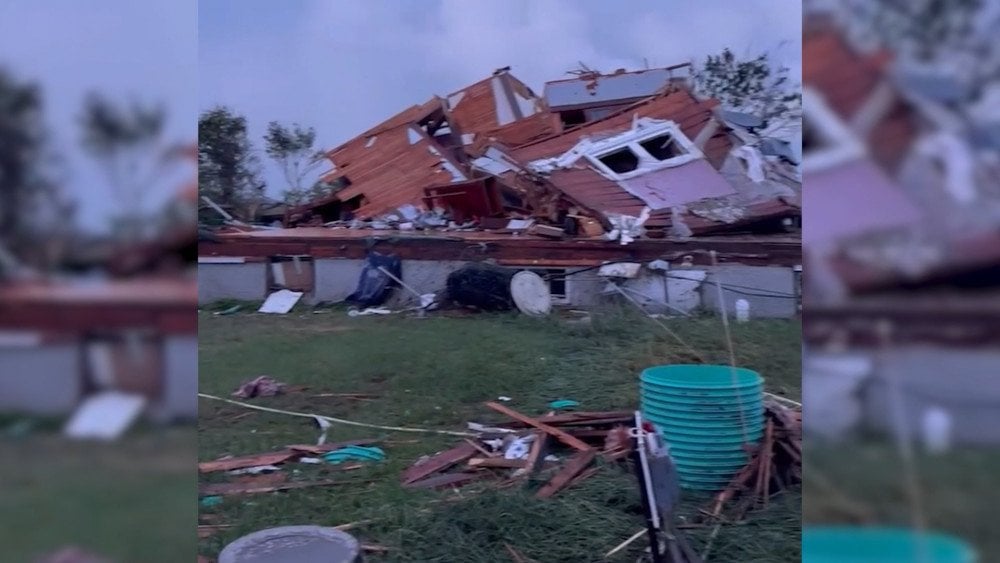
A powerful tornado destroyed a residential house in the state of North Dakota, USA
In North Dakota, an EF-3 tornado tore through the city of Enderlin. It destroyed homes and claimed the lives of three people.
Two more powerful twisters, an EF-3 and an EF-2, struck the suburban rural areas of Valley City.
In the area near the settlement of Luverne, a wind gust of 179 km/h (111 mph) was recorded.
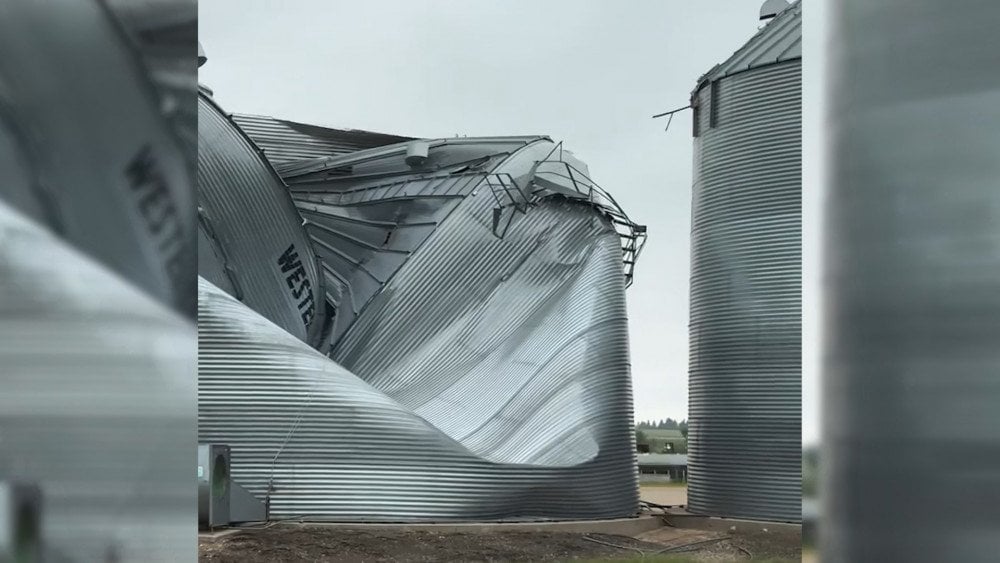
Damaged grain storage after the tornado in North Dakota, USA
In the state of Minnesota, hurricane-force winds with gusts up to 171 km/h (106 mph) struck the city of Bemidji and Beltrami County.
The disaster toppled thousands of trees, blocking roads and damaging roofs and vehicles. Sudden flooding occurred, gas leaks were reported, and power lines were brought down.
On June 22, the storm system struck the state of New York. Early that morning, an EF-1 tornado swept through Oneida County, destroying buildings in the village of Clark Mills and the city of Kirkland. Three people were killed when trees fell on their homes, including six-year-old twin sisters.
Notably, the state averages only one tornado for the entire month of June, but this year, three had already occurred in less than a month.
The storm brought torrential rains to the central part of the state. In Chenango County, up to 127 mm (5 inches) of precipitation fell within a few hours, triggering sudden flooding.
On June 23, a heatwave covered half the country—the northeastern USA—setting new century-long temperature records.

Extreme heat covered a significant part of the USA
More than 190 million people experienced stifling heat with temperatures above 32°C (90°F) and high humidity. In cities such as Chicago, Cleveland, and Raleigh, temperatures exceeded 38°C (100°F). Even nights brought no relief.
The heat was so severe that in Missouri, in the city of Cape Girardeau, roads began to deform.
Due to the extreme conditions, train speeds on the Washington–Boston route were limited, and one train was even evacuated after a one-hour stop without air conditioning.
On June 23 in New York City’s Central Park, the hottest morning ever recorded was measured— +27°C (80.6°F), and the daily maximum, +38.3°C (100.9°F), tied the record set 137 years ago.
On June 21 at Lake Tahoe, California, tragedy struck: an 8-meter (26 ft) boat with 10 passengers capsized near the shore due to a sudden storm. Eight people died, and two were rescued.
According to meteorologists, the storm appeared literally “out of nowhere”— calm weather was suddenly replaced by strong winds and waves up to 2.5 meters (8.2 ft) high. These conditions became deadly for the leisure boat.
Familiar weather patterns no longer work: a normal rain turns into a flood, and calm skies suddenly give way to a devastating hurricane. People are confused, not knowing how to react, because they rely on past experience — which no longer applies today.
When a person doesn’t know what to do, paralyzing fear takes over.
To avoid being helpless in a critical moment, it’s essential to equip yourself with knowledge ahead of time — to learn how to act in an emergency. If disaster strikes and you have no plan in mind, all you’ll find inside yourself is panic. Sometimes, even a single well-thought-out scenario can be your chance to survive.
When we’re prepared, when we know what to do — we act. And then fear becomes our ally. It gives our body adrenaline, helps us move quickly, and makes us more resilient.
It’s important to understand: saving your life is your personal responsibility. And once you realize that, you naturally start wanting to understand what’s really happening to the planet’s climate.
That’s why it’s worth taking a little time to learn how to evacuate properly and to prepare an emergency kit.
In chaotic situations, people instinctively follow the behavior of those around them. That means your calm and rational actions can set an example for others.
Take care of yourself and your loved ones. Even if they brush you off — talk to them. Show them how climate disasters are escalating today. That way, you can help both yourself and them.
This is really important. After all, life is the most valuable thing we have.
You can watch the video version of this article here:
Leave a comment